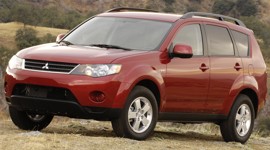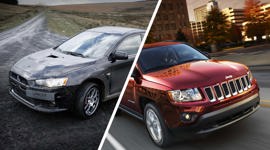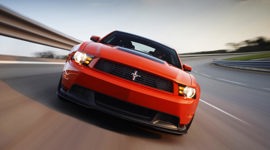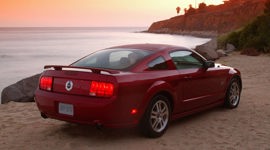Are you extremely reasonable and don’t like having any fun? Do you research quilts on Pinterest and frequent the Danielle Steele isle at your local bookstore? If so, skip the rest of this story, because we’re going to talk about getting you into a weekend racecar. Not just any racecar, but a racecar that’s easy on your wallet, easy on fuel, and that delivers maximum return on investment via the ability to drive it every single day of the year, if you like.
We’re not talking the sort of racecars that require a fire-suit, a racing team, and a trailer full of brake pads to campaign. Instead, we’re looking at some worthy recent rides that are track-day ready for owners who want to take in some friendly weekend lapping or racing in a car that doubles as their 9 to 5 commuter, and won’t turn wallets inside out when it comes time to fill up.
Best of all, most of the rides listed below can be had for a good deal this time of year. Winter is coming, and so is a flood of used rides that owners don’t want to store for the cold season if they’re set on upgrading.
Here’s a closer look.
2014–2016 Ford Fiesta ST

For Track Day:
Light and frolicsome and packed with a 1.6L turbo engine, the Ford Fiesta ST goes like bananas, feels finely tuned to generate grins on twisty courses, and won’t empty its tank in a particular hurry. One of the most amusing front-drive cars anyone’s ever driven, Fiesta ST is precisely calibrated and offers above-average levels of stability and feedback at speed. Look for durable brakes, a six-speed stick, and steering matched expertly to the weight and suspension viscosity of Ford’s entry hot-hatch.
Seating is a bit crampy for big dudes, but a hatchback cargo hold and folding rear seats for your extra tires and brake pads helps compensate. Bluetooth, Ford Sync, power accessories and plenty more are on offer too—meaning you can take your used Fiesta ST to work for the 9 to 5 when you’re not hitting a weekend lapping course.
The Test Drive:
You’ll have no trouble finding a good deal on a low-mileage used copy of this machine with plenty of warranty remaining. Check the Ford Sync system to be sure it works as expected, and ensure a dealer has installed all available software updates. Check for premature wear on the driver seat bolsters, calling any you detect into pricing negotiations. If the model you’re considering has been modified in any way, talk to a Ford dealership service manager to see if the warranty still applies.
Listen closely to the transmission, too. If it sounds like a film projector at any point in time, or shifts roughly, you might be driving one of a few early-build models that suffered from a bad transmission. Have the noise checked out and documented by a dealer if you buy the model in question, which may make it easier to achieve a replacement under warranty in the unlikely event of transmission failure. A squeaky clutch may be remedied with a little lubrication, though it could also indicate transmission problems.
2005–2015 Mazda MX-5

For Track Day:
The light weight that helps this little convertible turn in great mileage also helps reduce wear on its tires and brakes during hard driving. Excessive weight generates excessive heat in the vehicle's braking system and excessive stress on the tires. Since the MX-5 is little and light, drivers benefit from consistent braking performance with minimal wear, as well as extended tire life during sporty driving on weekend track days. In many cars, a few hours of lapping can leave the tires looking rougher than Courtney Love on New Year’s morning. With the MX-5, the rubber shows negligible signs of use, even after countless hard laps.
Look for all models from this generation with a 2.0L four-cylinder that’s simple, effective and tough, an available six-speed stick, and rear-wheel drive. Note, too, that lapping the MX-5 with the roof down feeds your peripheral vision heaps of information that helps place the car within its surroundings while relating it to the horizon. This is helpful for novices and experts alike, assisting with successful and positive reactions to skids and slides. This one’s confident, forgiving, and loveable driven to 100 percent of its capabilities by folks of all skill levels.
The Test Drive:
If you’re planning to drive your MX-5 only on occasion, or primarily on shorter trips, budget for a trickle charger and leave it hooked up to the battery when you’re not driving. This will keep the battery voltage topped up and prevent numerous troubles related to low battery output. You can get a cheap trickle charger at Canadian Tire or WalMart for about $30.
If opting for a manual model, confirm that the clutch is still healthy. You can coax slippage from a badly worn clutch by applying full throttle at low revs in a high gear (for instance, at 50 km/h in 4th gear) and watching for signs of slippage. Like the clutch, brakes will wear over time too—so be sure to make sure the seller isn’t trying to pass off a brake job.
Doing about 25 km/h in first gear, quickly tap the accelerator numerous times, causing the car to lurch aggressively, where appropriate. This will coax any unwanted sounds, typically clanks or pops, out of the driveline, which could indicate trouble with motor, differential or transmission mounts.
This one looks solid and reliable, and can be bought with confidence after a thumbs-up from a Mazda mechanic. Be sure to double-check the condition and operation of the convertible roof, with an eye for ensuring all weather strips are intact and healthy-looking.
2005–2012 Porsche Boxster

For Track Day:
This mid-engine baby supercar can now be had for under $20,000 all day long, and offers up flat-six engines ranging in displacement between 2.7 and 3.4 litres. Horsepower output ranged from 240 to just over 300. Look for manual or automatic transmissions, as well as Porsche’s ‘PDK’ dual-clutch gearbox. The latter transmission entered the Porsche Boxster lineup for 2009. If you’ll be lapping, it’s the Boxster S you’re after—it gets bigger brakes, more power, and a more sporty chassis. The mid-engine design enables the presence of two trunks, as well as some amazing handling that’s big on feedback and communication. Boxster seeks to put its full performance capabilities in the hands of its driver from the get-go, and delivers confidence, an eager-to-please attitude and an effortless dynamic, even when driven to its limit. This is a flattering, thrilling and fun car to drive hard, and the exhaust note and eager, effortless sensation of driving the stink out of it isn’t to be missed.
The Test Drive:
Approach any used Boxster checking for signs of electronics or wiring-related problems. Ensure all motorized or electronic features work as expected—including the stereo, power seats, climate control system, instrument cluster and lights. Note any warning messages or ‘check engine’ lights present, which could indicate a variety of problems.
Avoid a manual-equipped Boxster that shifts roughly, grinds, exhibits clutch slippage, or pops out of gear. If the shift lever feels difficult to move, the Boxster you’re test driving could be suffering from a worn-out engine mount. Additionally, an oil leak from the engine compartment could be the result of a bad rear-main seal. Reports of engine failure in earlier models, typically at low mileage, aren’t unheard of. Given the age of the affected models, this is likely of minimal concern to used shoppers, and might even get you into a unit with an engine that’s newer than the rest of the car.
Check the oil level before you purchase, and regularly afterwards, as some owners have reported excessive oil consumption. Low oil, or the requirement to add oil frequently, may be the result of a bad air-oil separator. If a little diaphragm in this component rips or tears, it can allow engine oil to be sucked up into the air intake in severe cases. Burning oil smoke from the exhaust, or a check-engine light referencing a vacuum leak are clues to this issue.
2012–2015 Scion FR-S / Subaru BRZ

For Track Day:
Scion’s back-to-basics sports car features extensive lightweight engineering, a high-revving 200-horsepower Boxer engine, six-speed transmission in the driver’s choice of automatic or manual, and every import tuner’s favorite feature: rear-wheel drive. This is one of the only cars in its class designed as, not modified into, a sports model from the get-go.
Low-slung and packing distinctive design elements and a Spartan cabin, this is a driver’s car that’s built for the average Canadian’s pocketbook. All models are two-door, four-seaters with a trunk. Handling response, steering precision and dynamic stability are top notch here, making the FR-S one of the ultimate driver’s cars in its price range. The snorty Boxer engine is a joy to put through its paces, and the overall package is exciting and fast. Fuel mileage is appreciably good, thanks to the modern 2.0L flat-four engine, too. On the track, you’ll feel the ‘sports-car-from-the-get-go’ engineering and light weight at every turn of the wheel—just prepare to upgrade the tires and brakes as your skill level increases.
The Test Drive:
Check the consumables on a used Subaru BRZ or Scion FR-S for excessive wear, as some owners have reported disappointment in the lifespan of factory-equipment tires and brakes. The presence of a check-engine light, traction control light, and non-operation of the cruise control could be the result of a bad wheel-speed sensor, and a cricket-like chirping noise, possibly accompanied by a check engine light, could be the result of a bad fuel pump. There was a Technical Service Bulletin issued for this problem, helping dealers to diagnose and fix the problem easily.
Another fairly common issue is heavy-rpm fluctuations at idle, or in neutral/clutch-in situations in models with the manual transmission. In many cases, re-flashed engine computer software fixes this issue. To date, other issues all seem to stem around interior squeaks and rattles.
2006–2013 Mini Cooper S

For Track Day:
Small is light, and light is good: good for fuel mileage, performance, handling, and other motorized shenanigans. Said shenanigans are the calling card of the Mini Cooper S—which packs a punchy little turbo engine with 180 horsepower or more, front-drive, a manual box, and some of the most distinctive looks on the road. Numerous options packages and special-edition models make the Mini Cooper lineup one of the most appealing on the market where selection is concerned. At track day, the predicable front-drive handling, frisky-pants chassis and durable braking system on S models adds confident speediness to the equation, and you’ll drive home getting great gas mileage, too. Plus, if you’re creative, you can even bring a cooler and some spare tires and wheels along for the ride in the cargo area. This one’s a total hoot.
The Test Drive:
Talk to a Mini service tech about possible timing chain issues in earlier copies of this model, from about 2007 to 2011. Apparently, Mini revised the tensioner system around 2011 to address issues with engine problems and failure. Changing the oil more frequently than the oil-life system in the Cooper S suggests may be a good defense against this issue. Note that a recall campaign was undertaken to address this issue.
Oil consumption may contribute to the timing chain tensioner issue on earlier turbocharged Cooper engines, too. Some owners report heavy oil consumption, others report none, and most debate how much oil consumption is considered ‘normal’. A revised valve cover with redesigned oil-separation passages helped by limiting the amount of oil ‘vapour’ allowed to be ingested back into the intake system via the PCV valve. The sticky? Check the oil, talk to a service tech, and plan to check oil levels and perform oil changes frequently.
A Turbo Timer, which lets the engine run a moment or two after being switched off, is a good thing for track-days, as it cools the turbocharger down more slowly. Signs of a bad turbo include smoke (particularly at idle when the engine is warm), sporadic performance under hard acceleration, and oil leaks out of the turbo housing, possibly into the ‘charge pipes’. Avoid a used model that’s been ‘chipped’ or ‘tuned’ to run more-than-factory boost levels, and opt for a 2012 or 2013 model if your budget allows it.
1999–2009 Honda S2000

For Track Day:
You’ll be the envy of the local Honda tuner crowd with your new S2K, thanks to its furious VTEC engine spinning to no less than an 8,000 RPM redline (9,000 RPM on older models)! Nearly bulletproof reliability, absolutely track-ready chassis components and all the goodness of roof-down, revs-up motoring were present here. Popular with retirees, enthusiasts, weekend racers and a wide range of other drivers, the S-two-grand was many things to many people. But mostly, it was a screaming little beast of a convertible that was ready for use on a circuit. Agile but forgiving handling and the never-ending sensation of screaming revs on the straight stretches will plant a grin on your kisser, with the slick gearbox and pedals perfectly-spaced for heel-and-toe work sealing the deal.
This machine is some of the most fun you can have in a car with your pants on. Look for 240 horsepower, rear-drive and a six-speed manual on all models.
The Test Drive:
Check for signs of rips, tears or leaking from the convertible roof, and be sure the rear window sewn into that top is clear and easy to see out of. Does the transmission ‘bite back’ at you when shifting, especially from first to second gear? Is the clutch excessively noisy? In either case, a Honda mechanic should have a look for signs of clutch or transmission issues. Repeated ‘biting’ or ‘gear clash’ when changing gears can be a serious sign of transmission trouble, too. Bring the VIN number of the model in question to your local Honda dealer and ask if there are any ‘service bulletins’ outstanding on the model you’re considering to fix niggling issues.
The Honda S2000’s easy-to-access four-cylinder engine can be compression tested by a mechanic in a matter of minutes ahead of your purchase. This quick check involves inserting an instrument into the vehicle’s spark-plug holes and turning the engine over to give a ‘compression’ reading. The reading of each cylinder is recorded, and the results can give a look at the engine’s overall health.
A buzzing sensation during deceleration is likely the clutch, and the issue can be fixed via a Technical Service Bulletin, though it won’t cause any damage left as is. If you hear a sound like a playing card going through the spokes of a bike-wheel from under the hood, a bad timing chain tensioner is likely to blame. This is unlikely, but a good reason to seek out another unit, or look for a hefty discount.
The highly knowledgeable and active S2000 owner’s community offers up this post regarding common issues, and their fixes, for your reference.
2008–2014 Subaru WRX/STI
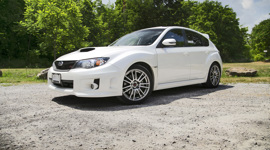
For Track Day:
This might be the ultimate weekend racecar and everyday sporty commuter for Canadian drivers. At track day, expect unflappable grip, forgiving suspension tuning that won’t kill you for your mistakes while you’re learning, and a broad power curve for easy access to maximum acceleration. With AWD, the Subaru WRX is less fussy about being powered too early out of corners, and becomes considerably easier to fire out of corners in the wet. Plus, with a proper cargo area and rear seats, you can bring your pals and their things along for the ride. Look for 265 horsepower on newer used copies, with the bumped-up STI variant pushing that figure past 300. Virtually all used models will offer a manual transmission and supportive seats, helping with track-day fun.
The Test Drive:
Most shoppers should avoid a model with more than minor modifications to intake and exhaust, which will be commonplace in the used market. Check all consumables. Be sure all fluid changes are up to date. Check for telltale signs of a bad turbo, such as oil leaks at the turbocharger plumbing, and white smoke at idle from the tailpipe. Note that numerous owners of various WRX variants have experienced cracked pistons and piston rings in response to turning the boost up to higher-than-factory levels, so be on the lookout for turbocharger system modifications, and avoid them.
Have a Subaru mechanic check over the model you’re considering, noting whether a recall on the turbocharger oil supply line has been carried out. Note that a number of owners of 2009 models experienced engine failure caused by a bad batch of engine bearings. This issue happened almost exclusively at low miles and was covered by warranty until Subaru addressed the issue.
Pay attention to the WRX’s idle, ensuring it’s smooth and steady at around 750 rpm. If that’s not the case, a bad sensor might be to blame. Ditto a rare but possible timing belt problem. For safety’s sake, be sure to determine where the timing-belt is within its lifespan, and don’t agree to purchase a WRX that doesn’t seem to be running smoothly until a mechanic checks it over.
2008–2015 Mitsubishi Evo

For Track Day:
Advanced control strategies, a super high-tech AWD system and fully networked chassis control systems all work to put virtually 100 percent of the Mitsubishi Lancer Evo’s performance capabilities in the hands of drivers from the first lap. With half a clue what you’re doing, this car sorts out all of the details for you, leaving you to lap like a total rock star. Robust low-end torque from the turbo engine, and standard All Wheel Control (AWC) AWD turn the dial up on grip and stability. Look for manual or dual-clutch transmissions, with higher-spec models boasting Brembo brakes and a wheel and tire upgrade. All copies got 291 horsepower from the factory and boasted a confidence-inspiring feel, as well as performance capabilities that were highly accessible, and ready to grow with driver skill levels. Don’t miss the punchy Rockford Fosgate stereo system upgrade, too.
The Test Drive:
Be absolutely sure all maintenance requirements have been adhered to—budgeting for a full fluid change (including differentials and transmission / transaxle) if you’re unsure. The Evolution has a lot of oily bits bolted to its floor-pan, and fresh, quality fluid is key to the long-term durability of these pricey parts.
Ask the seller to take you for a quick spin before trading seats and taking the wheel. Does the seller slip the clutch? Stall? Yank the gear-shifter like the leash of an unneutered pit bull trying to leg-hump a nearby lady-friend? Any of the above could indicate a rough driving style—meaning you’ll want to be triple-sure the clutch on the unit in question isn’t on its way out.
Some owners discuss ‘weak’ factory clutches in forums, in threads like this one and this one. Feel the clutch for signs of wear, and remember that if past sellers were fond of doing off-the-limiter clutch-dumps to entertain their buddies, said clutch will require replacement far sooner than later.
Note that numerous owners have had overheating issues with the TC-SST transmission in a track-day setting, whereby the gearbox goes into ‘limp mode’ when its fluid temperature exceeds a certain tolerance. Your writer had this happen to him first hand on a test drive, too. A larger transmission fluid cooler can fix the issue, and aftermarket solutions are available. Though unclear, it appears as though Mitsubishi fixed this issue after about 2010.
Numerous owners have reported rust-related failure of the AYC / ADC pump, which controls part of the All-Wheel-Control system. Ask a Mitsubishi mechanic to locate this pump, and confirm that it’s in good shape, and not rusted out and leaking. Many owners actually spray the pump with a rust inhibitor every year to protect it from corrosion.


